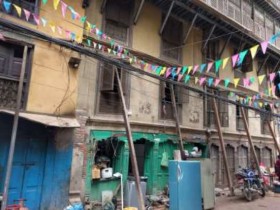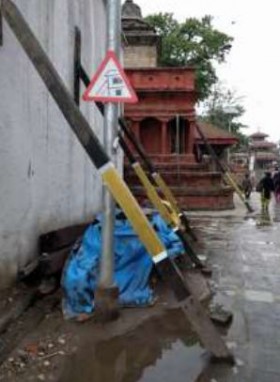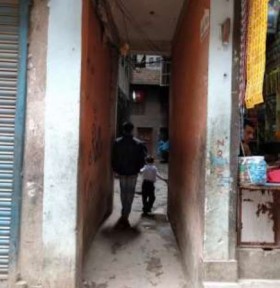 This is part of a series in which we share reports from Harvard students who have traveled to South Asia with support from a SAI grant.
This is part of a series in which we share reports from Harvard students who have traveled to South Asia with support from a SAI grant.
By Haibei Peng, Master in Architecture, Harvard Graduate School of Design, 2017
Haibei traveled to Nepal over the summer to work on her research project ‘The Nested Scale of Time: to protect and display biodiversity in South Asia through research on agriculture and seed bank.’
With the generous support from SAI Research Grant, I traveled through Nepal in May, 2016 for two weeks to conduct my thesis research on traditional Nepalese architecture and post-earthquake reconstruction in Kathmandu. During the two weeks I spent in Nepal, I traveled through Kathmandu, Pokhara and Chitwan national forest while talking to local residents, friends, foreign workers, volunteers and international organizations. Even though Nepal remains a poor country with bad infrastructure and is still recovering from the earthquake disaster, people here are all very friendly, welcoming and seem to share a happy attitude towards life and their country. Below are some of the most stimulating findings from my research.
Portal
What I found the most interesting during my time in Nepal is the housing typology of the traditional neighborhood in Kathmandu and particularly around Durbar Square. Walking down the narrow streets in the afternoon, food market and street vendors take over the already crowded streets. Pedestrians, bikes, cars and ricksha all cramp close to each other. On two sides of the streets, there are many narrow and short doors leading into a dark hall way. At first, I thought they are the entrances to private homes, then when I walked down one, I realized that after walking across the dark hallway while bending my back to avoid hitting my head, a big courtyard appears. Usually at the center of the courtyard is a small temple or statue, while surrounding it are many individual houses. I was told it used to be that one courtyard belonged to one big family, but with the development of the city during the past years, now the courtyards are usually divided up with different owners. Each building has a very small footprint because of the high land price. The buildings usually go up three to four stories, sometimes higher if the family needs more space. In many cases you can see clearly that the top floor was a recent addition. The narrow, short and dark tunnel leading from the busy street to the quiet courtyard is almost like a portal transforming your experience entirely. Within a courtyard, you can see kids playing and grandma walking around the Hindu statue to pray. It is the true local life.
From Durbar Square to residential homes, there are long wooden poles painted in yellow everywhere supporting the structures in danger. Piles of fallen structures and bricks still scatter everywhere. When asked about when/how the post-earthquake reconstruction is going to take place, no one I had talked to in Nepal seemed to be able to give an answer at all. At the Dunbar Square in Kathmandu next to the ruins, I found the conservation programme office where I spoke to architect Amit Bajracharya and Gaurav Shrestha. Both of them have worked here since the earthquake trying to help with the rebuilt program by collaborating with the Office of Archeology and other international organizations. Gaurav told me that the process has been slow because of the lack of resources and because the government officials keep changing. They seem hopeful that the reconstruction will eventually take place.
I met Toya Nath Subedi, a tour guide, at the Durbar Square, who knows some Chinese and was trying to talk to me and show me around to earn some money. When asked about the post-earthquake reconstruction, he shook his hand. He told me that the government initially told the people they will get some money to help rebuild their homes but it has not happened and probably will never happen. In terms of the historical sites, he felt heartbroken when they were destroyed because he has spent so much time around them growing up in the city. He said the government should have tried to re-stabilize the ancient structures with the help of technology a long time ago and there were international organizations who offered to help. However, because the government did not want their history to be “touched” by “foreigners”, it never happened and as a result the earthquake easily destroyed majority of the historical sites.
 I also visited the UNESCO Office in Kathmandu and spoke to consultant Thomas Schrom there. He has lived and worked in Kathmandu for the past couple decades. He spoke about some of the difficulties working on conservation projects in Nepal. He said that even though they get donations from the world, they have to get approval from the Nepalese government before they can work on the historical sites here. However, the local government still does not want to disclose many of the information and drawings because of their nationalism ideas and lack of trust.
I also visited the UNESCO Office in Kathmandu and spoke to consultant Thomas Schrom there. He has lived and worked in Kathmandu for the past couple decades. He spoke about some of the difficulties working on conservation projects in Nepal. He said that even though they get donations from the world, they have to get approval from the Nepalese government before they can work on the historical sites here. However, the local government still does not want to disclose many of the information and drawings because of their nationalism ideas and lack of trust.
Agriculture
Agriculture is an important part of Nepal’s economy. Before I traveled to Nepal, I read about how it counted for on average about 60 percent of the GDP but farmers have limited access to improved seeds, new technologies and market opportunities. It wasn’t until I was in Nepal traveling into the smaller villages when I understood why– the infrastructure here is underdeveloped. The mountain roads connecting major cities are narrow and congested. For example, traveling between the two major cities Kathmandu and Pokhara takes at least 6-7 hours even though the distance in between is only 124 miles. Because of these reasons, seedbank becomes particularly important for agriculture communities in Nepal so the local community can collect and store their seed resources. Currently, the ASIA Regional Agricultural Innovation Summit 2016 “Feed the Future” is having a session in Nepal to try to introduce new technology in Nepalese Agriculture.
International Responsibility
Nepal is known as the heaven for hikers. Many people may not know much about the country, but they certainly know about the peak, the tallest in the world, called Mount Everest. I visited the international mountain museum in Pokhara and was moved by people’s effort to preserve the history and culture of mountains and mountaineering here.
At the front of the main museum stands a statue to remember all the climbers who lost their lives here. I also met international Engineers who are also hikers working here in Nepal. One group I met has been trying to produce bio energy with the trash international hikers left behind at the last small village on the route for the Everest Mountain hike. When I spoke to them, they were very passionate about the project and the positive impact of it. They told me that they work for a big engineering company in the US and this has been their pro bono project for the past few years. They have gotten the local government’s approval and are trying to train a few local people to be able to operate the bio energy facility they are setting up. This will allow the local to turn waste hikers left behind into power they can use to make their life better and more convenient. The hospitality of people in Nepal is respected and appreciated by all the international visitors.

